Peace lilies are by far one of the most popular houseplants to grow because they are low maintenance and fairly easy to care for.
They can be a bit fussy though, so it’s very important to understand what they need to thrive. Once you get the hang of it, you’ll be able to enjoy them for many years to come.
In this complete care guide, I’ll show all you need to know about how to grow peace lily plants. Including details about water, soil, light, fertilizer, pruning, flowering, propagation, pest control, and much more.
Quick Peace Lily Care Overview
| Scientific name: | Spathiphyllum |
| Classification: | Tropical plant |
| Common names: | Peace Lily |
| Hardiness: | Zones 11+ |
| Temperature: | 65-80°F |
| Flowers: | White, can bloom year round |
| Light: | Full to partial shade, bright light indoors |
| Water: | Keep soil evenly moist, do not overwater |
| Humidity: | Average to high |
| Fertilizer: | General purpose plant food spring-summer |
| Soil: | Fast-draining, fertile soil |
| Common pests: | Spider mites, mealybugs |
Information About Peace Lilies
The peace lily (Spathiphyllum) is a very common indoor plant with lovely green leaves and stunning white flowers. It’s in the Araceae family, along with dieffenbachia plants and Chinese evergreens.
Though they are native to the tropical areas of North and South America and parts of Asia, they can easily adapt to growing indoors.
Commonly gifted as sympathy plants, they’ve gained a lot of attention in the past few years because they are air purifying houseplants.
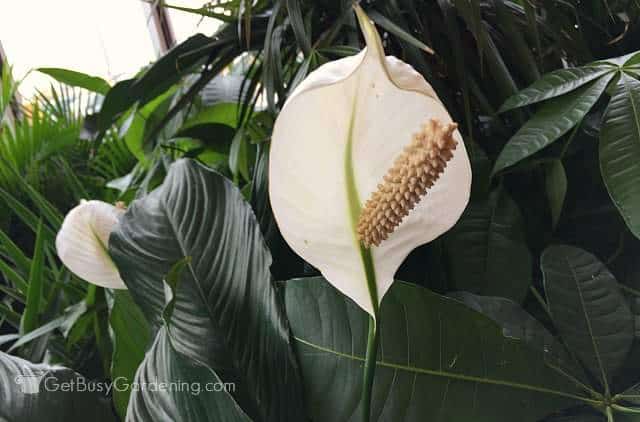
Different Varieties
There are several different types of Spathiphyllums, and they all require the same care. They look very similar to each other, but come in a range of sizes and foliage hues.
The sizes can be anywhere from the small varieties that only grow to be a few feet tall, to huge floor plants that are several feet tall. The leaf colors range from very dark to light green, or variegated.
Toxicity
All parts of the peace lily plant can be harmful if eaten. According to the ASPCA, they are toxic to cats and dogs.
If you have pets or small children around, then it’s best to keep this one out of reach. Otherwise, if you don’t want to risk it, check out my list of pet friendly houseplants.
Flowers
Most peace lily plants will bloom from spring through summer with the proper care. They are prized for their distinctive white flowers that stand above the foliage on tall stems. It’s the feature that most people recognize first.
They need lots of bright, indirect light to bloom. Once they’re done flowering, they usually have a rest period during the fall and winter months.
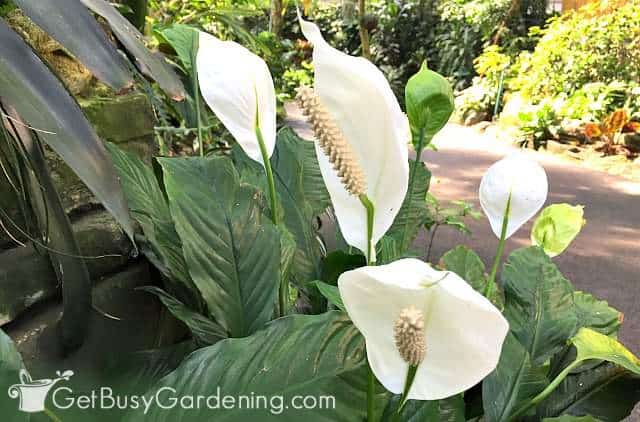
Peace Lily Care & Growing Instructions
Growing a peace lily isn’t difficult, but it’s important to give your plant the proper care so it will stay healthy and happy. Follow my detailed tips below for the best success.
Water
Proper watering is one of the most important parts of peace lily care, and giving them too much is their #1 cause of death.
They prefer to dry out slightly between waterings, and won’t tolerate wet feet for long. Push your finger 1-2 inches deep into the soil. If it feels damp, then don’t add anymore water. Use a moisture gauge to make it easy.
When it’s time, give your plant a deep drink, and allow the excess to drain completely out of the bottom of the pot – never leave it soaking.
It’s important to note that peace lilies are sensitive to the salts and chemicals in tap water. These additives can cause yellow or brown leaves, tips, and margins. So use distilled, filtered, or rainwater on them if you can.
Humidity
Since they come from tropical areas, peace lilies like a lot of humidity. They can adapt fairly well to lower levels, but extremely dry air will cause brown leaf tips and edges.
You can increase it by running a humidifier nearby or misting the leaves regularly to see if that fixes the problem.

Light
Peace lilies make great low light houseplants because they actually don’t like any direct sunlight. Too much sun will cause the leaves to fade, turn yellow, and/or burn.
However, they won’t grow well or bloom if it’s too dark. They need bright light, and filtered or indirect are the best.
Somewhere near a bright window or in a sunny room would be the perfect spots. If your home is too dark, then you can add a grow light.
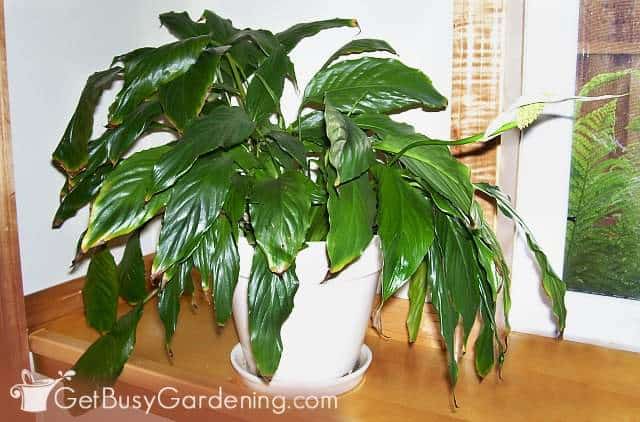
Soil
Peace lilies aren’t fussy about the type of soil you use, any high quality general purpose mix will work just fine. But they do prefer one that drains well.
If you tend to overwater, you can mix in some perlite, pumice, or coarse sand to increase drainage. They also like it slightly acidic, between 5.8 and 6.5 is a good range. You can use a probe tool to test it.
Repotting
Another thing that makes a peace lily so easy to care for is that they like to be pot-bound. In fact, they really hate being repotted.
So you should only repot yours if it’s absolutely necessary. When the time comes, it’s best to do it in the spring.
Also, make sure the new pot isn’t much bigger than the old one. They don’t like having too much space, so you should only go up one or two sizes. And always be sure to use a container that has drainage holes in the bottom.

Fertilizer
Peace lilies aren’t heavy feeders, but you should fertilize your plant a few times during the spring and summer months to encourage fresh new growth and flowers.
However, they are very sensitive to synthetic fertilizers. These harsh chemicals can cause major problems, like burning the roots, or making the leaf margins and tips turn yellow or brown.
I recommend using organic products instead. A few of my favorites are liquid compost tea, indoor plant food, or general purpose granules.
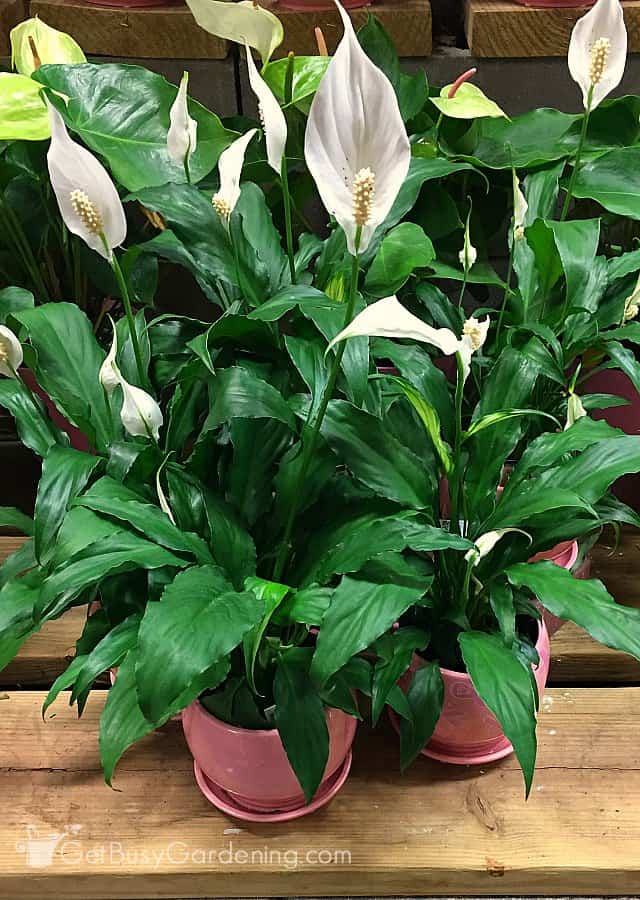
Tips For Controlling Pests
Healthy peace lily plants rarely have problems with bugs. But sometimes spider mites or mealy bugs can attack them.
If you find these pests, treat the leaves right away. Organic neem oil is a natural insecticide that is very effective at getting rid of them, and I highly recommend it.
Soapy water spray is also great for controlling pests. You can buy an organic insecticidal soap, or use a mixture of 1 teaspoon mild liquid soap per 1 liter of water.
Related Post: How To Get Rid Of Houseplant Bugs Naturally
Pruning
To keep your plant tidy and looking its best, you can prune it as part of your regular peace lily care routine. Here are some pointers:
- Remove brown leaf tips and edges by trimming them at an angle following the natural shape of the leaves.
- Cut dead or dying foliage all the way down to the base of the plant.
- Prune out faded or brown flowers and stems to help encourage more blooms.
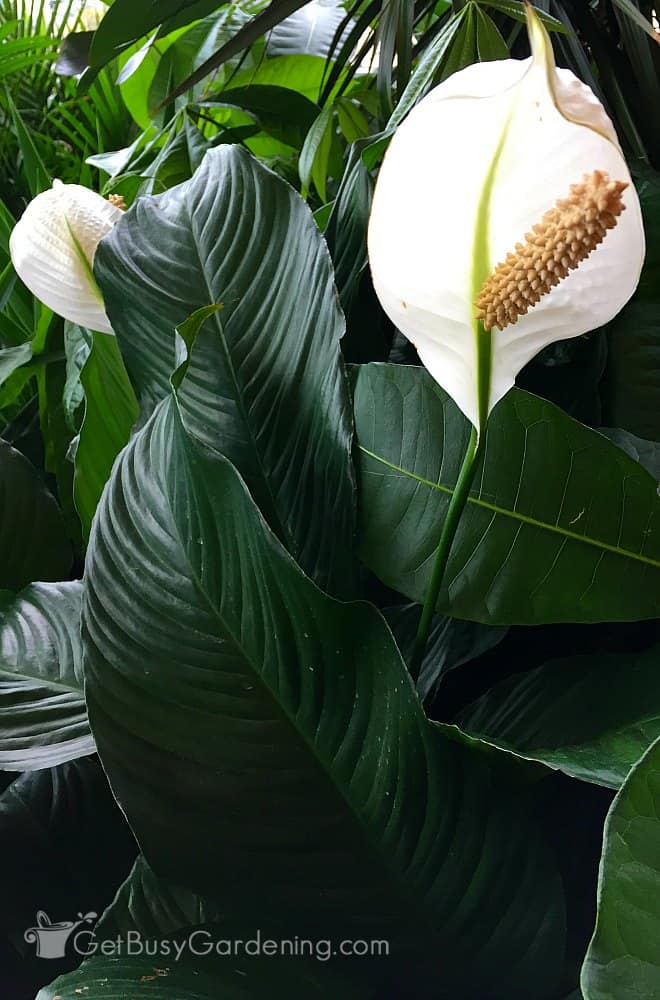
Peace Lily Propagation Tips
The only way to propagate a peace lily is to divide the rootball. To do this, remove it from the pot and gently untangle the roots – carefully working to separate the offshoots from the main plant.
If the rootball is really thick and dense, you may need to use a knife to cut it apart. Just be sure that each individual stem has roots, or it will not survive on its own.
Troubleshooting Common Problems
Peace lily care can be a bit daunting when your plant starts having problems and you don’t know why. Here’s a list of some of the most common issues, and tips for how to fix them:
Plant Is Drooping
Drooping is usually caused by over or under watering. But it can also be from sudden changes in temperature, or transplant shock after repotting.
If you recently moved it to a new pot, it should recover in a few days. Otherwise, check the soil and only water if it’s dry. Move the plant if it’s in direct sun, near a heat source, or exposed to a cold draft.
Leaves Turning Yellow
It’s normal for the older bottom leaves to turn yellow as they die, so you can simply prune those off. But if others are yellow, or there are several of them that turn at once, then it’s probably from overwatering or bugs.
Inspect the leaves for pests, and check to make sure the soil isn’t overly wet. It should dry 1-2″ deep between drinks.
No Flowers
The most common cause of a peace lily not blooming is inadequate lighting, they need bright light to flower.
Feeding your plant during the spring and summer, and regularly deadheading spent flowers will also help encourage blooming.
Brown Leaves Or Leaf Tips
This is almost always caused by improper watering, lack of humidity, or chemical damage from using tap water or synthetic fertilizers.
A yellow or white crust on top of the soil or around the inside pot edges are telltale signs of a salt or chemical buildup. Try using distilled, filtered, or rainwater instead, and switch to an organic fertilizer.

FAQs
Peace lilies can only live outside year-round in the warmest most tropical climates of zones 11+. They are extremely sensitive to cold weather, so if you choose to put yours outside during the summer, be sure to bring it back indoors before it drops below 65°F.
The most common cause of death for peace lilies is overwatering. The soil should dry 1-2″ deep, and never feel wet or saturated. Other common reasons are from chemical fertilizer burn, or prolonged exposure to hot or cold drafts.

Now that you’ve learned exactly how to care for a peace lily, you’ll be able to enjoy your plant for many years to come. I know it can seem overwhelming, but you’ll get the hang of it in no time.
If you want to learn all there is to know about maintaining healthy indoor plants, then you need my Houseplant Care eBook. It will show you everything you need to know about how to keep every plant in your home thriving. Download your copy now!
More Plant Care Guides
Share your peace lily plant care tips in the comments section below.

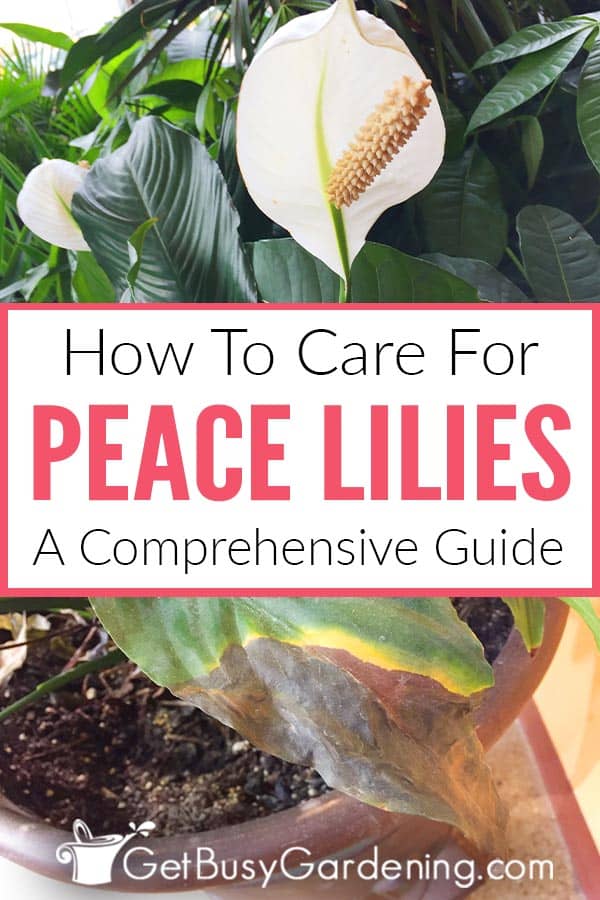
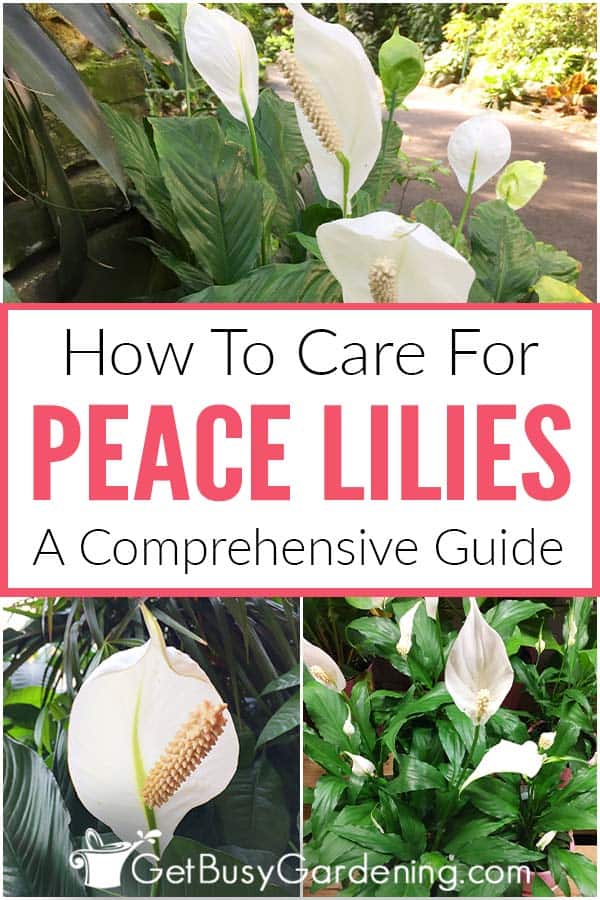



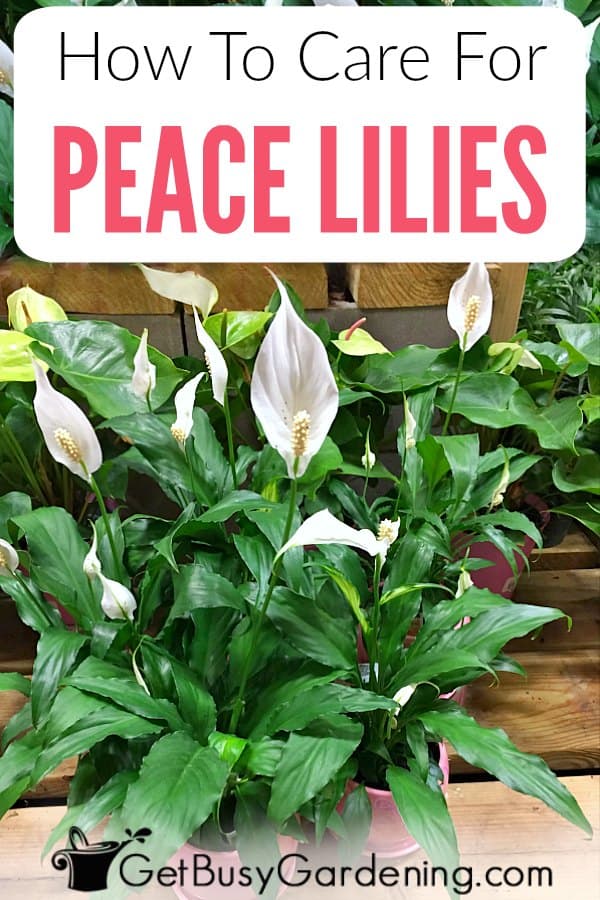




Bob says
My Peace Lily has stopped blooming and that is okay because I like the foliage. The problem is that the plant develops white powder on some of the leaves. I don’t know where it is coming from. I don’t see any bugs but the leaves do get dark brown or black. I am closely watching so that I don’t over water. Do you have any suggestions?
Amy Andrychowicz says
The white powder on your peace lily leaves could be mealybugs. They look like powder or cotton on the leaves rather than bugs. Otherwise, it could be a type of mold. If that’s the case, then make sure you only water your plant at the base and not over the top of the leaves.
Cheryl says
Great info! My peace lily has little brown spots on the leaves, so I’m hoping to fix the problem using this info. I wanted to read the dieffenbachia article, but there is something wrong w/ the link – the page won’t load!
Amy Andrychowicz says
You’re welcome, glad to hear you found this article helpful! I hope it will help you fix any problems you’re having with your peace lily plant! That’s for letting me know about the link to the other post. It seems to be working for me now, so it was probably a weird glitch. Here’s the link if you want to try it again. How To Care For Dieffenbachia. 🙂
Cheryl says
It’s working – thank you!!!
Amy Andrychowicz says
Wonderful!
Plant Lover says
Hi Amy,
I have another Peace Lilly, that was in a smaller arrangement, along with two other planets from my Mom’s funeral 4 yrs ago, Peace Lilly only plant that survived, unfortunately it has only 4 or 5 little leaves has not grown at all, have watered it when needed, repotted in a pot quite large, thinking maybe repot in the spring is into a smaller pot, what plant food might I use to promote growth.
Amy Andrychowicz says
Bummer, sorry to hear your peace lily is struggling. If it’s in really bad shape, then I wouldn’t repot it. But they do like being pot-bound, so the large pot may be the problem. I would definitely make sure you’re not accidentally overwatering it, which is easy to do when the pot is large. Stick your finger an inch into the soil to check how wet it is. As for feeding it, read through the section above titled “Fertilizer For Peace Lily”. I have some links in there with different types of fertilizers I recommend. Good luck!
Plant Lover says
Thanks, might not have been watering enough, was doing it in the lavatory and transporting water with large measuring cup, tried sink using faucet hose, watering lasted longer this time. Might try adding a bit of soil, maybe repotting in the spring.
Amy Andrychowicz says
You’re welcome!
Plant Lover says
Hi Amy,
Your advice to water my peace Lilly with soapy water to get rid of ants seemed to do the trick, looks much greener (ph in dish soap), possible.
Plant is in pot from florist with moss, I am having to water once a week, water drains really fast, do I need to add potting soil, drama queen droops every 7 days or so, after watering perks up beautifully.
Amy Andrychowicz says
Wonderful, glad to hear that the soapy water did the trick! If there’s room in the pot to add more soil, then I would start by doing that. The ants may have displaced enough of the soil that there’s a lot of empty space in the pot now. Otherwise, your peace lily may be pot bound, so you could certainly try repotting it into a slightly larger pot in the spring.
Audrey Oliver says
Hi Amy,
I have a similar problem to Plant Lover above. I have had my peace lily since my dad past away 10 years ago. I had it for 5 years before it even bloomed again. I repotted it once in that 5 years. I’m not sure that it was ever “perfectly” healthy, but I was never worried about it being ill or in danger. I think the lighting spot I had for it was a really good one. It’s been another 5 years, and I just propagated it, and repotted it into about 5 different planters, making sure they all had drainage holes. Unfortunately, as soon as I repotted it, we decided to do a full house remodel, and move to a temporary house while the work was being done. I brought my 5 plants over to the new house, and tried to put them in perfect spots. Our temporary house has a door, next to a window that has a shear curtain on it. I put the biggest (main plant) pot there. Almost instantly, I noticed a difference with the leaves turning yellow, brown, black, and them bending and breaking (like disconnecting itself at the “neck”)at the base of the leaf (where it connects to the stalk).
In fear, I put it out in the rain to get some rain water, because I know that is good for them. I didn’t leave it out for more than a couple of hours, but I noticed that it didn’t do much for the leaves even after a few days or weeks. Day by day, I watched the leaves turning with confusion of what was happening. It’s been about 2 weeks, and just today, when i looked at it, I was wondering if it was freezing (not burning like plant lovers), as our main living is upstairs (nothing downstairs but the front door, the garage door, and a coat closet). I realized that every time I go down there, i am freezing, and the heat that we use upstairs doesn’t travel downstairs well.
Anyway, I just brought it upstairs, but now I am wondering how to prune it to give it a chance. The water level is dry, so I think I will water it, but pretty much all the big leaves are dead. It has a few bushels of smaller leaves (their own root ball, not connected to the main plant) that are still green and healthy (no browning whatsoever). I noticed that it looks like new leaves (plant stalks maybe?) grow out from the sides of stalk/stem of the other leaves. Because of this, I am wondering if I should just cut the whole dead leaf off (at the “neck” ) or just cut the whole stem (at the base of the plant). Doing this, might be the end of the whole part of what was originally the main plant. It would be sad, but I am ok with it, considering I have many off shoots, but I just wanted to make sure that that was the best thing to do. Also, if I do that, should I just take out the main root ball? This would leave only a few baby plants in a very large pot.
Lastly, if the small plants are left in the big pot, will this affect how I water it? It would take a ton of water for me to use enough for it to drain out of the drain holes, which is what a lot of things I read, says should happen. I know I shouldn’t replant into a smaller pot now, because of it’s issues. Would maybe a moisture gauge be my best option??
I hope this all made sense, and thanks in advance for your response. You have been sooo helpful to so many people.
Amy Andrychowicz says
When you moved your peace lily to the temporary home, could it have been exposed to extreme temperatures, like freezing cold or maybe left in a hot car? It only takes a few minutes for a plant to be damaged when exposed to extreme temperatures. I once left a plant in my car during the summer for less than 10 minutes, and it completely fried. The same can happen if you move a houseplant during the freezing cold without any protection. It can freeze almost instantly. If your peace lily was exposed to extreme temperatures during the move, then that would explain the sudden problems with brown, black and yellow leaves. It sounds to me that there’s one larger plant and a few smaller ones in the same pot. And the way you described it, it sounds like to largest of the plants in the pot may be dead? If that’s the case, then you can just cut the dead one all the way down to the soil level. I would wait until spring to see if the other plants in that pot recover, and if they do, then repot them into a smaller pot. Peace lilies like to be pot-bound, and I’m afraid that those little plants won’t do very well in a large pot. Good luck!
Plant Lover says
When watering my peace lily, noticed small ants on the counter after I removed it. Is there anything I need to do. Plant still looks good.
Amy Andrychowicz says
The ants probably built a nest in the pot, but they won’t hurt the plant. I would water your peace lily with soapy water for the next few waterings to see if you can kill the ants. They’re just a nuisance, but I’m sure you don’t want them living inside your house!
Plant Lover says
Nope don’ t want them taking up residence in my house.
Thank you,
Plant Lover
pamela jeanette knight says
Please help ! I have the peace lily that was sent to my uncles funeral. I am trying so hard to care for it to keep it from dying. Im not sure if im over watering or not giving it enough water. the leaves are droopy but some of the leaves are yellow and brown. its sitting in the corner of living room away from the window where at one time it was thriving. now i have this problem. i felt the soil it feels moist but thats on top not sure about the bottom of the plant. i have it sitting on a plate and the plate is dry but again the soil on top feels good and moist. please any advice on how to save this plant. i have already killed one overwatering it in the past.
Amy Andrychowicz says
Oh no! Sorry to hear your peace lily is ailing. Most of the time, the problems are caused by too much water. Unfortunately, they will droop if they are over OR under watered, so you must check the soil to know for sure. Peace lilies like to dry out a bit between waterings. If the soil is moist, then I would wait until it dries out a bit before watering it again. Once the top of the soil is dry to touch, then stick your finger one inch into the soil to check if it’s still wet. Once it feels dry down that deep, then you can water it again. You can also buy a soil moisture gauge to help you figure out when it’s time to water.
Danny says
I have a friend that brought me their Peace Lily because it is in pretty dire straits. Many of the leaves are drooping and dieing off. I am not sure of their water habits other than at times they would forget to water it and it would bounce back and be fine after watering. They recently repotted the plant and there is not enough soil in the pot, which I will rectify. But, I am not sure how to get this plant to bounce back. They brought it to me because I seem to have quite the green thumb when it comes to house plants. I will check to see if the pot they put it in drains. My guess is, it does not. They have had the plant for several years and it just started doing this recently.
Amy Andrychowicz says
It’s very common for peace lilies to droop after being repotted, they don’t like to be repotted. I would leave it alone and just monitor if for several days to see how it reacts to being moved. Definitely don’t repot the peace lily until you can get it to recover, and don’t give it any fertilizer either. Continue to monitor the soil moisture level, and only water it when the soil dries out a bit. That’s about all you can do until you can figure out what’s ailing the plant, or get it to recover. Hope it pops back to health for you!
Plant lover says
Have had my peace Lillie, for two weeks placed it near front door that has a sheer curtain, leaves the are facing door seemed like they were drooping, watered it leaves still droopy not much, rest of the plant still perky. I ordered a moisture meter to help maintain it properly as I want it to thrive, plant from son’s funeral. Is the plant leaning to get more light?
Amy Andrychowicz says
So you’re saying your peace lily is leaning, but not drooping? It is possible that it’s reaching for light if it’s in a really dark spot. Definitely start with getting the watering right, that’s going to be half the battle with peace lilies. Also, since it’s by the door, check for drafts. If it’s getting hit with freezing cold air every time the door opens, then that is probably the problem.
Plant Lover says
Thank you Amy. Received moisture meter, has a watering guide grouping plants into zones depending on type of plant, peace lily not listed, which tropical plant would I associate it with. Doesn’t even have botanical name on the list, does have a blue zone that determines no watering, but concerned about light and ph.
Amy Andrychowicz says
I’m not sure if you have the same moisture meter that I do, mine didn’t come with a list of plants, LOL. Anyway, for a peace lily, I would let it get to the point where it’s just at the “dry” level on the meter before watering it again. You don’t want to allow the soil to get completely bone dry, but it shouldn’t be damp at all.
Magda says
My peace Lily blooms a green flowers .. Is it natural ? Thank you
Amy Andrychowicz says
Yes, it’s normal for peace lily flowers to turn green. The flowers usually start out green, eventually turn white, and then back to green as the flowers start to age. But for some varieties the flowers stay green. However, green flowers can be a sign that something is wrong, like improper watering, light, and/or fertilizer. If your plant is otherwise healthy, then I wouldn’t worry about it.
Evelyn says
Hello, I’ve had my peace lily for a couple of months now, but I’ve been struggling to keep it alive lately. The leaves are getting brown, and I was wondering if I should trim the brown part only or the whole leave!?? And thank you for your articles. They really are the best!
Amy Andrychowicz says
You’re welcome! 🙂 Check the soil to make sure it’s not too wet. The most common problem with peace lily plants is overwatering them. Brown tips on peace lily plants is a super common problem. You can prune the leaves to only remove the brown edges, or trim out the entire leaf if it’s mostly brown. See the “Troubleshooting Common Peace Lily Problems” section above to help you figure out what could be causing the brown leaves on your plant.
Christina says
I have a Lilly for 6 years now. It was thriving and growing, so I decided to separate it. I separated it a few months ago and repoted the main root into a LARGER pot. Unfortunately now, it is not doing so well. It looks like some of the root may be dying (main root) and the leaves are drooping and some are brown. The other pots are also drooping and brown. One pot does have new growth in it tho.
Why is my peace lily drooping after repotting? Could the pots be to big?
I haven’t changed anything such as watering or feeding.
Please Help!!!
Amy Andrychowicz says
Drooping is a common problem after repotting peace lily plants. But if they are struggling to recover, then it could be that the pots are too big, which can lead to overwatering. Peace lilies like to be pot-bound. I would allow the soil to dry out a bit between waterings, and mist your drooping peace lilies to raise the humidity level and help encourage new growth. If they are suffering right now, then I would not recommend repotting them again because the shock could kill them. The fertilizer could also be causing problems. It’s not good to fertilize a newly repotted plant until it has recovered from transplant shock. Hold off on feeding your peace lilies again until they recover. Good luck!
Julie Norris says
I have a ten year old plant that has grown very tall trunk leaning over . Do I need to put something in to tie each trunk up. The leaves are pretty but about two feet from soil. Thanks for your help.
Amy Andrychowicz says
It may be time to repot your peace lily plant into a larger pot if you haven’t done that it a while. Otherwise, yes, you could tie it up if you would rather do that.
Carol LAwson says
I have a peace lilie for 7 years do you ever have to repot it is in a big pot and doing well I put out on pouch in the summer. Just wonder if or when they need to be repotted.
Amy Andrychowicz says
Peace lilies like to be pot bound, so as long as yours is growing and healthy, then there’s no need to repot it.
AMISHA says
I have planted my peace lily in only coco peat. Because when I purchased it it came only in coco peat….is it ok? If it is not so suggest me best potting mix for peace lily…& If it is ok then how to fertilize peace lily
Amy Andrychowicz says
I’ve never tried growing peace lilies in coco peat before, but if that’s what your plant came in, then I’m sure it will be fine. Peace lilies aren’t fussy about the type of soil. However they are very sensitive to the type of fertilizer you use, so be sure to use an organic liquid fertilizer rather than a synthetic one. I wrote details about fertilizing peace lilies in the post above, so please refer to the “Fertilizer For Peace Lily” section above for details. 🙂